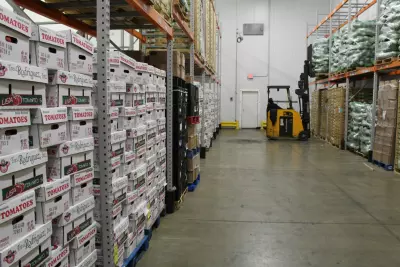Ohio’s food banks are set to receive $7.5 million less in the state budget than they did last year. Some lawmakers quibble with calling that a cut, and there’s a logic to their argument.

The additional funding was a one-time supplement, approved in 2023, while the state was flush with federal COVID relief dollars. Now, some argue, the economy is back on its feet, there are plenty of job openings, and it’s time for the state to dial back assistance programs.
But the people maintaining that safety net say the need is greater than it’s ever been.
There’s an echo of the 2024 presidential election in that disconnect. The economy might look good on paper, but many are still struggling to make ends meet. Housing costs are rising. Wages aren’t keeping up. Inflation rates have come down. Grocery bills haven’t.
People who work in the food assistance system regularly point out that when money is tight, food is the first place families cut back. You can’t reduce your rent or electric bills, but you might be able to save some money leaning on canned goods or mac and cheese.
The state budget maintains food banks’ core appropriation of about $24.5 million year. But Mike Hochron from the Mid-Ohio Food Collective explained that’s the same funding they received in 2019. Back then his organization fed about 50,000 families in Franklin County each month. Now it’s 100,000.
“I don’t know how you’re supposed to serve twice as many people with the same amount of resources,” he said. “It means being really creative. It means being really efficient, and it also means figuring out how to make do with less.” Workers setting up at the Faith Fellowship pop-up food pantry.

Photos by Nick Evans
Faith Fellowship in Circleville
For a couple hours every Saturday, Pastor Susan Roark’s Faith Fellowship congregation runs a pop-up up food panty in an empty lot on Circleville’s Court Street. This is the front line of Ohio’s food assistance system. In communities all over the state, pantries provide households with groceries like meat, dairy, fruits, vegetables and grains.
An hour before they open, workers are lugging banana crates packed with food from a box truck and trailer. They’ve got a ring of folding tables steadily filling up with canned goods, produce and bread. A man pulls out a step stool to hang a large blue Faith Fellowship sign on the truck. Nearby a few workers are laying out used clothing.
There’s already a line of people waiting.
At one end of the lot there’s an old motor home. Inside Cecilia Seckman and Mary Martin are filling Styrofoam trays with food. This sets the Faith Fellowship pantry apart from many others. Visitors can pick up the typical panty basket, but they can also leave with a hot meal.
“We’re gonna have ham and potatoes, green beans, rolls, and cake,” Seckman says as she dips food out of a couple of crock pots. Tomorrow is Easter; a man from another church donated 17 hams.

Mary Martin, left, and Cecilia Seckman, preparing meals for food pantry visitors.
The germ of Faith Fellowship’s pantry came from one of their congregants, William Michael Brown. He worked with a street ministry in nearby Chillicothe and wanted to bring the idea to Circleville.
“The Bible says you’re supposed to feed and clothe the needy,” Brown said matter of factly. “We all do what we’re supposed to do, it’s all trying to follow the Bible.”
He’s proud of how their effort has grown — “It’s just been a bloom,” he said — but the demand worries him a bit, too.

William Michael Brown is a member of Faith Fellowship Church and encouraged the congregation to start a food pantry.
“I don’t know if it’s the wages, if it’s the cost of living, or what it is,” Brown said.
“They come from everywhere,” he added. “It’s a need.”
Eric and Ashley Wharton made the drive from Chillicothe. Eric said the pantry gives them some breathing room amid the rising cost of living. “I’m door dashing, but I’m barely surviving,” he said. Getting a hot meal on top of the pantry basket makes a huge impact for them.
“If you put the price on that, that’s $8-10 if we’re gonna go buy it,” he said. “So, I mean, that puts $10 back in my pocket that I can use for gas or use for something that’s a little bit more important.”
Talisha Myers said the extra meals take a lot of work off her plate.
“I have five kids, and then plus my father-in-law lives with us, so it’s like, it’s really hard,” she said. “We don’t qualify for food stamps or anything, because they say me and my husband make too much together.”
Roark’s congregation is only about 50 people, but they serve a couple hundred pantry visitors and give out about 250 meals each week. After only half an hour they’d given out 125 meals.
“I think the need is greater than our capacity to meet that,” she acknowledged. “And there are other organizations in town that are working to meet different needs, but all of us together still can’t meet the need.”

Faith Fellowship co-pastor Susan Roark.
The Mid-Ohio Food Collective
Standing behind organizations like Faith Fellowship are the food banks. While pantries operate like a storefront, food banks serve as distribution centers. Ohio has regional 12 food banks, and with a 20-county footprint, the Mid-Ohio Food Collective is the largest.
“We’re sending food every day out as far as Steubenville — a three hour drive each direction,” Hochran explained. “So, whether that’s as far north as Marion, down south to Chillicothe and all the way out east to the West Virginia border, that’s all our territory.”
Mid-Ohio supplies food to more than 600 support organizations from a warehouse in Grove City. The building is the size of three football fields; think Costco but crawling with forklifts instead of shoppers looking for samples. Fully stocked, the warehouse can hold roughly 7 million pounds of food. But the goal, Hochran explained, is to move that stock out rapidly — sometimes the same day it arrives.
“Almost two thirds of what we distribute at Mid-Ohio is fresh food,” he said. To get produce out the door they proactively send out fresh food alongside the items pantries have ordered.
“We know you’re going to serve a couple hundred families today, that’s going to be about —make up a number — four pallets worth of fresh produce,” Hochran said. “We’ll pick from what we have and send out a good variety of it, because we don’t want this stuff sitting in our cooler for three days.”
A case in point is stacked up five feet tall on about twenty pallets.

Ohio Association of Food Banks Executive Director Joree Novotny (left) and Mid-Ohio Food Collective Senior Vice President of Communications Mike Hochron.
“This is a good example of perfectly wholesome, delicious cabbage,” Ohio Association of Food Banks Executive Director Joree Novotny explained. “But it’s not going to have a retail market. It’s not up to size, up to snuff, in terms of what a retail customer is looking for and what our traditional grocers are looking for.”
That cabbage was purchased through an Ohio program helping farmers recoup their investment in produce that doesn’t quite make the grade for your local grocery store.
“So rather than see this all end up staying out in the fields or end up in a landfill, we’re able to bring it in at pennies on the pound,” Novotny added.
As she’s explaining that, forklifts are filing up and carrying away one pallet after another. While Hochron shows off a large display where they track delivery trucks in real time, more forklifts start unloading a new shipment. This time it’s pallets of yellow squash.

Worker stocking shelves at Mid-Ohio Food Collective.
Statewide perspective
Novotny explains food banks around Ohio are getting squeezed in multiple ways. More people need their help, support programs are holding steady or rolling back and the money food banks have doesn’t go as far as it once did.
She points to seniors as an example. The Ohio Association of Food Banks estimates 70,000 Ohio seniors receive the minimum $23 benefit through SNAP, the federal food stamps program. But during the pandemic, the minimum SNAP benefit was more than $200. So where do they turn to make up the difference?
“Well, a good example, if you look right over here on these shelves,” Novotny said, “these are some of the raw products that come directly from the USDA for the Commodity Supplemental Food Program, which is a small but mighty program that food banks operate in Ohio.”
The problem is funding for that program has remained flat. The cost of groceries certainly has not.
“It’s a good sort of microcosm,” Novotny said, “of how that purchasing power that’s been more limited means less food for vulnerable people.”
Novotny said they’re seeing similar funding challenges at the state level. To explain their current circumstances, she reaches all the way back to the Great Recession. It took food banks a decade to settle at a “new normal” in 2019. At that point, she said, they were delivering take home groceries to about 850,000 times a quarter.
“Since then, putting all increases in need aside, if we were serving the same number of people today, we have significantly reduced purchasing power,” Novotny said. She noted the consumer price index for food has risen almost 24% in the last four years, and they’re not serving 850,000 households a quarter — they’re serving 1.4 million.
“We need some help,” she said, “to help adjust to that inflationary pressure.”
In their budget request, the Ohio Association of Food Banks asked for an inflation supplement of about $5 million on top of the $24.5 million they’ve been receiving since 2019. That request fell on deaf ears.
In February, House Finance chair, state Rep. Brian Stewart, R-Ashville, predicted that his caucus would keep historical funding in the budget but “maintaining a level of funding that we had at the worst economic times we’ve had is just probably not gonna be what we do.” That prediction held.
Novotny insisted “we will always have some food to provide,” but with government support at the state and federal level standing still while prices rise and more families seek out support, something’s got to give.
“We are already lightening the load significantly to each person who’s coming to us for help,” she said.
Follow Ohio Capital Journal Reporter Nick Evans on X or on Bluesky.
Ohio Capital Journal is part of States Newsroom, a nonprofit news network supported by grants and a coalition of donors as a 501c(3) public charity. Ohio Capital Journal maintains editorial independence. Contact Editor David Dewitt for questions: [email protected].







